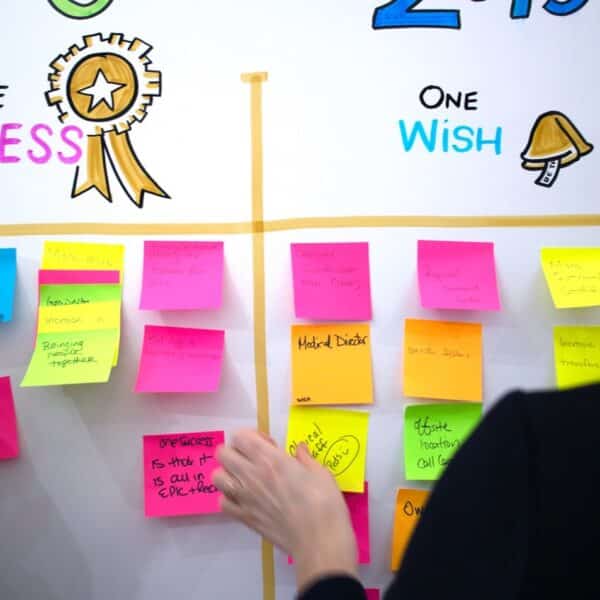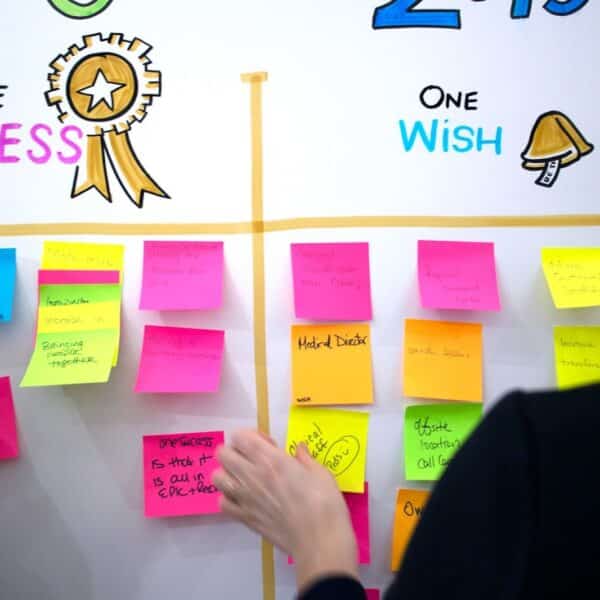You’ve just spent two hours in a product strategy meeting. Everyone was engaged, ideas were flowing, and by the end, the team felt aligned on the roadmap ahead.
Then someone asks: “So what did we decide?”
Cue the awkward silence as everyone flips through their scattered notes, trying to piece together what just happened.
Sound familiar?
We see this pattern constantly in our work with product teams. After 15 years of facilitating roadmap sessions for companies like Google, LinkedIn, and Salesforce, we’ve learned that the problem isn’t the conversation—it’s how teams capture and share what was discussed.
This is where visual note taking changes the game. Instead of pages of bullet points that no one will read again, visual notes create a living artifact—a roadmap at a glance that everyone can see, understand, and rally around.
Key Takeaways
- Visual note taking transforms complex product roadmaps into clear, memorable visuals that align teams faster
- Product teams using visual notes see improved cross-functional communication and reduced misalignment
- You don’t need artistic skills—simple techniques like timelines, icons, and color coding create effective visual roadmaps
- Both analog (whiteboards, markers) and digital tools (iPad, Miro, Mural) work for visual note taking
- Visual roadmaps become living artifacts that guide daily decisions, not static documents that get forgotten
Let’s explore how we help product teams use visual note taking to turn complex strategy discussions into clear, actionable roadmaps.
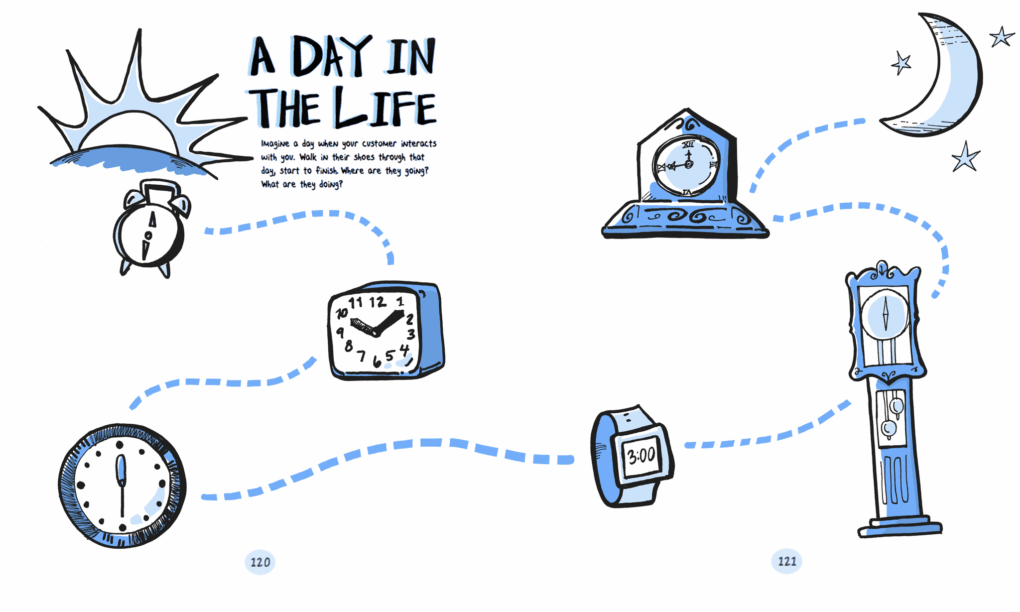
What Is Visual Note Taking?
Visual note taking is the practice of capturing ideas, decisions, and information using a combination of words, drawings, icons, and spatial relationships. Instead of linear text, visual notes organize information the way our brains naturally process it—through patterns, connections, and visual hierarchy.
For product teams, this means transforming roadmap discussions from dense documents into clear visual maps that show:
- What you’re building and when
- How features connect to strategic goals
- Dependencies between initiatives
- Priorities at a glance
The result? Everyone leaves the room with the same understanding of where the product is headed.
Why Product Teams Struggle with Roadmap Communication
In our experience working with product teams across industries, roadmap complexity is universal. Teams need to balance:
- Multiple stakeholders with competing priorities
- Technical dependencies that aren’t obvious to non-engineers
- Timeline constraints that shift as you learn more
- Strategic goals that need to translate into tangible features
Traditional roadmap formats—whether spreadsheets, slide decks, or project management tools—often fall short because they:
- Bury key information in tabs, pages, or nested views
- Require context switching to understand relationships
- Feel static and disconnected from real-time conversations
- Don’t capture the “why” behind decisions
Visual note taking solves these challenges by making the invisible visible. When we sketch out a roadmap in real time during strategy sessions, we’re not just documenting—we’re facilitating shared understanding. That’s the foundation of The ImageThink Method™.

How Visual Note Taking Improves Product Planning
Alignment in Real Time
When our visual strategists capture roadmap discussions live, misalignment becomes immediately obvious. If someone sees their priority missing or misrepresented on the visual, they speak up right away—not three weeks later. We’ve watched this happen in hundreds of sessions: the visual becomes a mirror that reflects what’s actually being said versus what people think they’re agreeing to.
Faster Decision-Making
Visual roadmaps help teams compare options side-by-side, spot conflicts, and prioritize faster. Instead of debating abstract concepts, you’re pointing at a shared visual and making concrete choices together. We’ve seen two-hour debates resolve in fifteen minutes once the options are visible.
Better Cross-Functional Communication
Engineers, designers, marketers, and executives all process information differently. Visual notes bridge those gaps. An engineer can see technical dependencies mapped out, while a marketing lead can track feature launches against campaign timelines—all in one view. This is why our clients at organizations like Morgan Stanley and NASA rely on visual facilitation when cross-functional alignment is critical.
Memorable and Shareable
People remember visuals far better than text. A well-crafted visual roadmap becomes the artifact that teams reference again and again, keeping everyone aligned as execution unfolds.
As our founder Nora Herting writes in Draw Your Big Idea, “Visual communication breaks down the barriers between strategy and execution. When teams can see their roadmap, they can act on it.”
Since founding ImageThink in 2009 as the first graphic recording firm on the East Coast, we’ve facilitated hundreds of roadmap sessions where visual note taking turned information overload into clarity—and strategy into action.
| Aspect | Traditional Notes | Visual Note Taking |
|---|---|---|
| Format | Linear text, bullet points | Spatial diagrams, icons, timelines |
| Information Density | Sequential, requires reading | At-a-glance comprehension |
| Alignment Speed | Slow—requires interpretation | Fast—everyone sees the same thing |
| Cross-Functional Use | Difficult for diverse teams | Accessible to all roles |
| Memory Retention | Lower—text based | Higher—visual + spatial memory |
| Collaboration | Individual note-taking | Shared visual artifact |
| Updates | Requires rewriting | Easy to modify and iterate |
Visual Techniques for Product Roadmaps
Effective visual note taking isn’t about artistic skill—it’s about using simple techniques to organize information clearly. Here are the core methods we’ve refined through 15 years of working with product teams:
Sketching Roadmap Milestones
We use a horizontal timeline to show phases, releases, or quarters. Key milestones get visual anchors—circles, flags, or icons—so they stand out at a glance.
Example: A timeline showing Q1 through Q4, with major feature releases marked as milestone flags and smaller initiatives as dots along the path. We’ve used this format for product teams at companies like Cisco and Dell EMC to map multi-year technology roadmaps.
Using Icons, Color Coding, and Hierarchies
- Icons represent different types of work (new features, bug fixes, infrastructure, research)
- Color coding distinguishes themes, teams, or priority levels
- Size and placement show relative importance and dependencies
This visual hierarchy lets people scan the roadmap and immediately understand what matters most. We often hear from clients that they finally “get it” once they see their roadmap with this visual structure.
Mapping Dependencies Visually
We draw arrows or connecting lines to show how initiatives relate. If Feature B depends on Feature A being complete, that relationship should be visible—not buried in a footnote.
Visual collaboration tools make this even more powerful, allowing teams to see how changes in one area ripple across the roadmap. In our Strategic Visuals service, we spend significant time mapping these dependencies because they’re where misalignment typically hides.
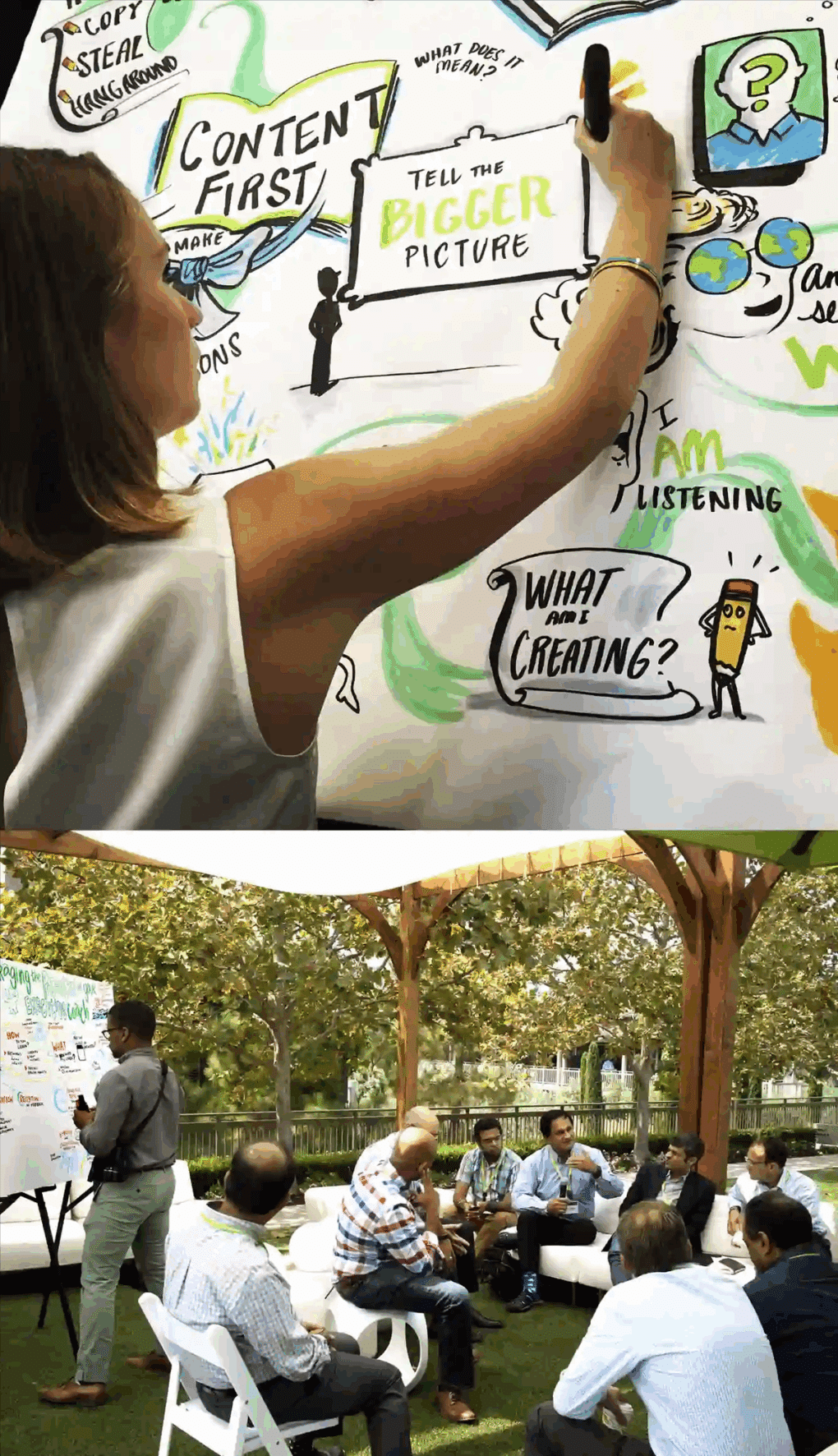
How to Create Your First Visual Roadmap in 5 Steps
Step 1: Set up your canvas
Choose your medium (whiteboard, foam board, or digital tool) and create a basic timeline structure showing your planning horizon (quarters, months, or sprints).
Step 2: Identify major themes or workstreams
Create swim lanes or sections for different product areas, teams, or strategic themes. Use color coding to distinguish them.
Step 3: Plot key milestones and releases
Add major deliverables, launches, or decision points along your timeline. Use visual markers like flags or stars to make them stand out.
Step 4: Map dependencies and connections
Draw arrows or lines showing how initiatives relate. Highlight critical path items or blocking dependencies.
Step 5: Add context and refine
Include icons for work types, labels for clarity, and any important notes. Step back and test: Can someone unfamiliar understand it in 30 seconds?
These are the same steps our visual strategists follow when facilitating roadmap sessions, whether we’re working with a 10-person startup or a Fortune 100 enterprise.
When to Use Visual Note Taking for Product Teams
Use visual note taking when:
- Planning quarterly or annual product roadmaps
- Running sprint planning or retrospective meetings
- Aligning cross-functional teams on strategy
- Presenting roadmaps to stakeholders or executives
- Facilitating brainstorming or ideation sessions
- Resolving conflicts about priorities or dependencies
Best for teams who:
- Struggle with alignment across departments
- Have complex products with multiple dependencies
- Need to communicate strategy to non-technical stakeholders
- Want to create artifacts that teams actually reference
Consider alternatives if:
- You need detailed project management tracking (use visual notes alongside PM tools)
- Your team is fully remote and prefers async communication (digital visual tools still work well)
We’ve found that visual note taking works across virtually every product context—from healthcare technology to financial services to consumer apps. The common thread is complexity that needs to be made simple.

Tools and Templates for Visual Note Taking
You don’t need fancy software to start with visual note taking. Here’s what we use and recommend based on facilitating roadmap sessions for Fortune 500 companies and fast-growing startups:
For analog visual note taking:
- Large whiteboards or foam boards for team sessions
- Markers in multiple colors for coding and hierarchy
- Sticky notes for movable roadmap elements
For digital visual note taking:
- iPad with Apple Pencil (using apps like Procreate or Notability)—this is our primary tool for digital graphic recording
- Collaborative platforms like Miro or Mural for remote teams
- Digital whiteboards in Zoom or Microsoft Teams
Templates to try:
- Timeline roadmap with swim lanes for different teams
- Now/Next/Later framework with visual groupings
- Theme-based roadmap showing strategic pillars
The key is choosing tools that match your team’s workflow. The best visual notes are the ones people actually use and reference. We’ve seen teams print large-format versions of their visual roadmaps and hang them in their workspace, and that’s when you know the visual is working.
Best Practices for Visual Note Taking in Product Meetings
Start with Structure
Before the meeting, we sketch out a basic framework like a timeline, themes, or key questions. This gives the visual notes a foundation and keeps the conversation focused. We learned early on that starting with blank space can feel intimidating; a light structure invites participation.
Capture Ideas, Not Transcripts
You’re not trying to write down everything said. Focus on key decisions, priorities, dependencies, and open questions. Our visual strategists distill conversations into their essence. This is a skill we’ve honed over thousands of sessions—knowing what to capture and what to let go.
Use Visual Shorthand
We’ve developed a simple icon library over the years: lightbulbs for ideas, question marks for unknowns, checkmarks for decisions, arrows for dependencies. Consistency helps teams read visuals quickly. Many of our clients adopt these same icons for their internal work.
Make It Collaborative
We invite team members to add to the visual. When people contribute directly, they feel more ownership over the roadmap and are more likely to remember what was discussed. Some of our best sessions happen when a product manager grabs a marker and starts sketching alongside us.
Review and Refine
After the meeting, we clean up the visual notes for clarity. We add labels, adjust spacing, and ensure the roadmap tells a coherent story. Then we share it immediately while the conversation is fresh, which is usually within 48 hours, delivered through a password-protected gallery.
This is where The ImageThink Method™ really shines. As pioneers of graphic recording since 2009, we’ve developed a proven approach that goes beyond simple documentation. Our visual strategists facilitate thinking in real time, helping teams work through complexity and build visual roadmaps that drive action. We’ve done this with companies for product companies like Google, LinkedIn, AirBnB, —organizations that depend on clarity when the stakes are high.
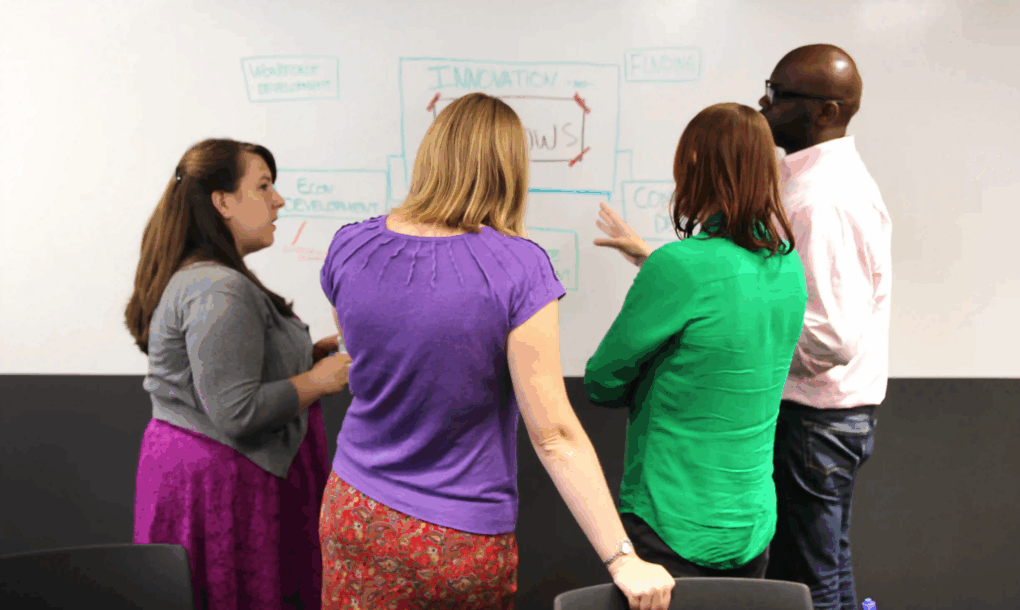
Real-World Example: Visual Roadmaps that Drive Alignment
A mid-sized SaaS company came to us struggling with roadmap alignment across engineering, product, and sales. Every quarter, they’d create a detailed roadmap document, but by week three, teams were already out of sync.
We facilitated their quarterly planning session using live visual note taking. Instead of presenting a pre-built roadmap, the product leader facilitated a conversation while our visual strategist captured it live on a large-scale visual roadmap.
The team could see:
- Which features supported which strategic goals (color-coded by theme)
- Dependencies between engineering work and go-to-market needs (shown with connecting arrows)
- Timeline conflicts that needed resolution (visually overlapping initiatives)
By the end of the session, they had a single visual artifact that everyone understood and agreed on. The roadmap stayed on the wall in their office, and teams referenced it daily. When priorities shifted mid-quarter, they updated the visual together, keeping alignment without lengthy status meetings.
That’s the power of visual note taking for product teams: it turns abstract strategy into tangible direction.
This isn’t an isolated case. Over 15 years, we’ve facilitated roadmap sessions for product teams at organizations ranging from Fortune 100 enterprises to venture-backed startups. The pattern is consistent: when teams can see their strategy, they execute faster and stay aligned longer.
See Your Product Strategy More Clearly
Product roadmaps shouldn’t be documents that live in a folder somewhere, only to be dusted off for quarterly reviews. They should be living, breathing artifacts that guide daily decisions and keep teams aligned.
Visual note taking makes that possible. By capturing roadmap discussions visually—with timelines, dependencies, and priorities all visible at a glance—you create clarity that sticks.
The next time you’re planning a product strategy session, ask yourself: What would this roadmap look like if we could all see it together?
You might be surprised how much faster your team moves when everyone’s looking at the same picture.
We’ve been helping teams answer that question since 2009. And we’d love to help yours.
Frequently Asked Questions
What is visual note taking?
Visual note taking is the practice of capturing information using a combination of text, drawings, icons, symbols, and spatial organization. Instead of traditional linear notes, visual notes use diagrams, timelines, color coding, and visual hierarchy to organize ideas in a way that mirrors how our brains naturally process information. For product teams, this means creating roadmap visuals that show relationships, dependencies, and priorities at a glance.
How does visual note taking help product teams?
Visual note taking helps product teams by creating shared understanding in real time, improving cross-functional communication, and making complex roadmaps easier to remember and reference. When teams can see their strategy visually—with milestones, dependencies, and priorities mapped out—they align faster, make better decisions, and stay synchronized throughout execution. Visual notes become living artifacts that guide daily work rather than static documents that get forgotten.
What tools are best for visual note taking?
The best tools depend on your team’s workflow and preferences. For in-person sessions, whiteboards, foam boards, and colored markers work well. For digital visual note taking, iPads with apps like Procreate or Notability are popular, along with collaborative platforms like Miro, Mural, or digital whiteboards in Zoom and Microsoft Teams. The most important factor is choosing tools that your team will actually use and that allow for easy sharing and reference after meetings.
How can visual notes improve roadmap communication?
Visual notes improve roadmap communication by making abstract strategy concrete and visible. Instead of describing a roadmap in paragraphs or spreadsheets, visual notes show timelines, feature relationships, dependencies, and priorities spatially. This allows stakeholders to quickly grasp the big picture, spot conflicts or gaps, and understand how their work connects to broader goals. Visual roadmaps are also more memorable and easier to share across teams with different technical backgrounds.
What are the benefits of using visuals in product meetings?
Using visuals in product meetings accelerates alignment, reduces misunderstandings, and keeps discussions focused. When ideas are captured visually in real time, everyone can see what’s being discussed, which makes it easier to spot disagreements or missing information immediately. Visuals also help diverse teams—engineers, designers, marketers, executives—communicate across different thinking styles. Finally, visual artifacts from meetings serve as shared references that keep teams aligned long after the meeting ends.
Can non-designers do visual note taking?
Yes! Visual note taking doesn’t require artistic talent or design skills. The most effective visual notes use simple shapes, basic icons, arrows, and color coding—all things anyone can do. The goal is clarity and organization, not artistic beauty. With practice, anyone can learn to capture ideas visually using basic techniques like timelines, boxes, circles, and connecting lines.
What’s the easiest way to start visual note taking?
Start small with your next team meeting. Draw a simple timeline or framework on a whiteboard before the meeting begins. As the conversation unfolds, add key points, decisions, and action items to the visual using basic shapes and arrows. Focus on capturing the big picture rather than every detail. After a few sessions, you’ll develop your own visual shorthand and style that works for your team.

You Might Also Wonder
How long does it take to create a visual roadmap?
A basic visual roadmap can be sketched in 15-30 minutes during a meeting. More polished versions for stakeholder presentations might take 1-2 hours to refine and digitize.
Do visual roadmaps work for remote teams?
Absolutely. We facilitate visual sessions for distributed teams regularly using digital tools like Miro, Mural, and virtual whiteboards. Remote visual collaboration often increases engagement since everyone can contribute simultaneously.
How often should we update our visual roadmap?
Treat your visual roadmap as a living document. Update it whenever priorities shift, milestones are reached, or new information emerges. Many of our clients do quick visual updates weekly or bi-weekly during standups.
Ready to transform your product planning sessions? At ImageThink, we’ve spent over 15 years helping product teams at companies like Google, Salesforce, LinkedIn, and Morgan Stanley build clearer roadmaps using visual thinking and The ImageThink Method™.
We don’t just capture what’s said—we help teams think through complexity and turn strategy into visual clarity that drives execution. Learn more about our visual facilitation services or reach out to discuss your next planning session.

